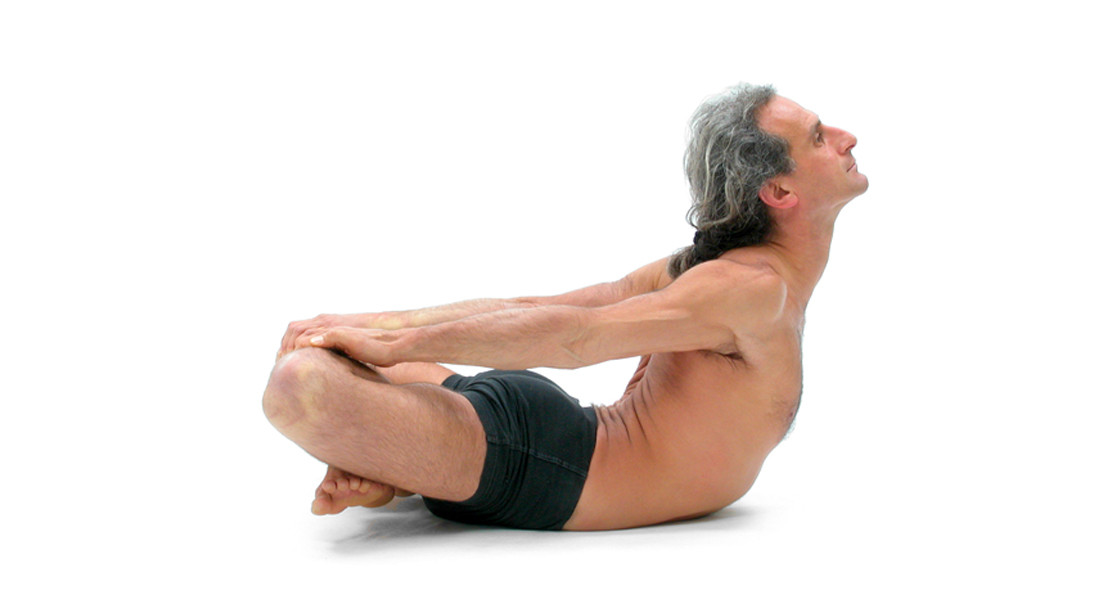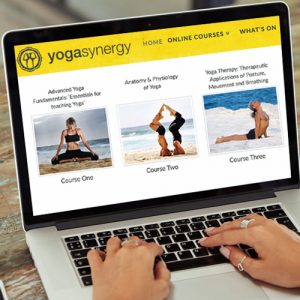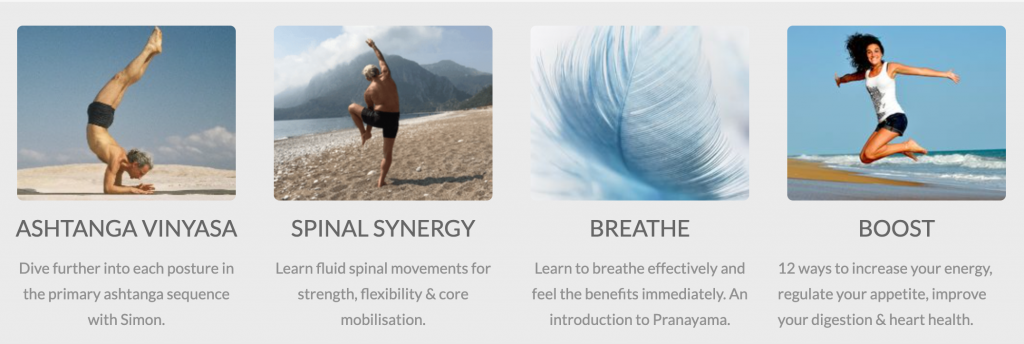How to ‘open’ your mid-spine in back bends and not squash your lower back

When you maintain length in the front of the hips and then breathe into the abdomen during a back arch this helps to ‘open’ your middle back without compressing your lower back (please click to enlarge photo)
*** Lengthen your Psoas at the hips (hip extension) and immobilse L5-S1
*** Breathe in to your abdomen (use your diaphragm)
*** Breathe out from your chest (ha-uddiyana bandha)
*** Psoas then extends your spine from T12-L5 (and not L5-S1) because the diaphragm attaches to the psoas, which joins to T12-L5
Most modern adults tend to have very stiff middle backs (usually from about the tenth thoracic vertebra (T10) to the fourth lumbar vertebra (L4). This region (T10-L4) is stuck in a slight forward bend (spinal flexion) in many modern adults. These people usually do most of their bending backwards (spinal extension) from the very lowest part of the mobile spine at junction between the fifth lumbar vertebra and the first sacral vertebra (L5-S1). L5-S1 is usually located about 2 centimetres below the top of your hips (iliac crests).
Since this part of your spine is below the top of the hips, it is actually very hard to relieve compression there by bending the spine forward because when most people bend forward, they primarily do so bending forward from the hips, which is something we are very good at doing due to our primarily seated lifestyle in which we are always bending forward from the hips. Once you have the ability to bend from the spine rather than the hips you have the key to relieving back pain and also the key to doing very safe and effective ‘backbends’ (spinal extension postures).
This ‘info-graphic’ put together quite loosely describe the steps you can do in a backward bending (spinal extension) posture. These steps will help you bend backwards where most people tend to be stiff – between T10 and L4 – and bend forward (spinal flexion) where most people tend to be compressed (and often stuck in a permanent backward-bending state (spinal extension) at L5-S1.

Psoas Major (orange); showing how the spinal attachments of the psoas also attach to the diaphragms;
When you maintain length in the front of the hips and then breathe into the abdomen during a back arch this stimulates a ‘stretch reflex’ activation of the psoas muscles which will help to further extend the spine at T12-L5 without hyperextending the L5-S1 (please click to enlarge photo)
The solution to this problem relies on gaining control of and learning to use a combination of the following important muscles:
* Psoas major – bends the hips forward (hip flexor activity) and also bends the spine backwards (spinal extensor activity). If the psoas is over-tense, or spasms, it can be the cause of lower back pain because it will pull the L5-S1 joint of the lower spine into a backbend (spinal extension).
* Rectus abdominis – the abdominal ‘six pack’ muscle that can keep the front ribs inwards and is the main muscle of bending forward. This muscle, when active, can help reciprocally relax your back muscles, which are often too tense.
* The diaphragm – the main muscle of breathing, which when being used makes you more relaxed and feel like you are breathing into the abdomen.
* Hip extensors (such as the buttocks muscles and the hamstrings) – these muscles can help stop the hips from bending forwards and help to prevent the psoas muscle from squashing the lower back by causing hyper-extension at L5-S1, which can cause lower back pain.
It is possible in any backward bending position to use a combination of muscles to prevent the hips from bending forward (i.e. encouraging hip extension). In backward-bending (spinal extension) postures this action prevents the L5-S1 from bending backwards. The simplest instructions to get this effect are to move sitting bones (ischial tuberosities) forward (towards the navel), move the top of the hips (iliac crests) backwards (away from the navel) and move the navel forward. The navel in the front of the waist corresponds to the region of 4th and 5th lumbar vertebrae (L4-L5), which are just above the sacrum. We can refer to the region of L4-L5 as the ‘navel spine’. When you consciously move the navel forward, without moving the top of the hips forwards this also tends move the ‘navel spine’ forward and to move the L5-S1 joint into a more flexed (less bending backwards) and less compressed position, which can relieve most lower back pain.
Moving the navel (and ‘navel spine’) forward can be done using a combination of the diaphragm and/or the rectus abdominis. This action can be trained if you practice abdominal inhalation while doing a half sit up; or practicing abdominal inhalation while carefully dropping part of the way down toward the floor as if you are about to ‘drop back to Urdhva Dhanurasana (the ‘Inverted bow posture’), or rather to Ustrasana (the ‘Camel posture’), which is safer and simpler for most people.
To begin to open your spine to the possibilities of bending backwards (spinal extension) where it is mostly stiffer around the region of the middle back (especially from the middle thoracic spine to the fifth lumbar vertebrae), without over-bending backwards (hyperextending) at the L5-S1 junction, you can do the following things. Immobilise the hips in an extended position (so there is length at the front of the groins) and breathe into the abdomen. This will give the best spinal extension especially if your rectus abdominis (the spinal flexor muscle we use while doing a half sit-up exercise) is active (as it is when dropping backwards), and holding your front ribs inwards. Once you breathe into your abdomen with your diaphragm you usually start to feel the middle of your back begin to bend backwards (sometimes for the first time since being a child), while actually relieving any compression around L5-S1.
This is largely due to two main reasons:
1. The fact that the psoas muscles actually join onto the transverse processes of the vertebrae T12-L5 (see anatomy photo) and can therefore bend the spine backwards at these vertebrae if they are not allowed to make L5-S1 bend backwards.
2. The fact that the diaphragm is a dome-shaped muscle that actually joins onto the psoas (see anatomy photo), and so when the diaphragm becomes active (i.e. when it contracts as you inhale into the abdomen) it pulls on the psoas, and even causes the psoas to become active (via the ‘stretch reflex’), which will cause the T12-L5 begin to bend backwards.
You can apply these principles in any backward-bending (spinal extension) posture – even while simply standing up ‘straight’ and trying to lift your chest..

Simon Borg-Olivier in Baddha Hasta Janu Simhasana; lengthening hip flexors and breathing diaphragmatically allows the body to smoothly bend backwards (spinal extension) along the complete length of the spine

Bianca Machliss in Kapotasana,breathing into the abdomen and out passively from the chest stimulate the diaphragm to activate the psoas muscle and bend the stiffest parts of the spine

Bianca Machliss lowering back into Urdhva Dhanurasana, which obligatorily actives spinal extensors (especially rectus abdomens) and reciprocally relaxes back muscles
In the photos attached you can see me using this method while doing Baddha Hasta Janu Simhasana (grabbing my knees in a ‘lotus cobra’) and you can see in this posture how I am bending inwards (backwards) in my mid-spine quite fully (this feels incredible in fact – like an incredible self-massage).
In the other photo you can see me dropping backward into a backward arch, while slowly lowering down using the rectus abdominis and so no ribs can stick out. Once you feel your ribs sticking out in a backwards arch (urdhva dhanurasana) you can be pretty sure your L5-S1 has been compromised due to compression. This is of course what happens to most people once they touch the floor in a backwards arch. In fact there is less risk of injury while lowering to a back arch from standing than there is once you touch the floor. This is of course hard to control and much easier to do in the camel pose.
The real art is to keep the rectus abdominis on, while in the back arch, or while in camel pose or any backwards-bending posture.
Additional Information on Bending Backwards (spinal extension):
This is a ten minute video about how to safely do backward bending movements in a way that can relieve lower back tension and compression. I made this non-professional quality video some time ago purely for the use of some of my private clients but several people have asked me to release it for the general public.
The information presented here mainly talks about how to the ‘Camel’ pose (Ustrasana) and it’s related postures but it can also be applied all backward bending postures including the standing back-bending (spinal extension) posture Utthita Virabhadrasaa, which is described in the Spinal Movements (Part 22) sequence shown in a previous blog.
DISCLAIMER: the sound quality is video is not perfect. My voice is slightly obscured by the sound of some machinery in the background, and the image of my body practicing does not always show the complete body.
Main points to consider when bending backwards (from the video):
- There are two ways to bend backwards (spinal extension).
- You can either lengthen the front of your trunk or you can shorten the back of your trunk.
- When you bend backwards it is generally better (for about 90% of adults) to do it by lengthening the front of your body and not by shortening the back.
- To bend backwards from a standing position to a backward arch posture (urdhva dhanurasa), or to lower backwards from an easier posture such as the ‘camel posture’ (ustrasana), it is good to think of moving your navel and your ‘navel spine’ (L4-L5) forward and upwards (which lengthens the front of your body), as opposed to moving your navel and your ‘navel spine’ (L4-L5) backwards and downwards (which shortens the back of your body).
- Lengthen the skin of your back with no creases in the skin if possible
- Move your collar bone away from the floor and tail bone closer to the floor.
- Breathe in to abdomen to reciprocally relax the muscles of forced abdominal exhalation that tend to harden the lower back
- Move your groins forwards to lengthen (extend) the front of your hips.
- If you lean backwards this can make the front of your trunk firm and the back of your trunk relaxed.
- Ideally you will have the middle front of the abdomen firm (rectus abdominis) and the sides of the abdomen (abdominal oblique muscles) relaxed.
- It is always good to check that your neck is relaxed, your fingers can move and that you can comfortably breathe into your abdomen.
- The real art will be to keep this feelling when your hands touch the floor or your ankles. It is easy to maintain the eccentric activation of your rectus abdominis.
- At any time you should be able to let go of the floor or your ankles and your trunk should feel the same.
- The purpose of holding the floor or your ankle is so you can enhance the activity of your abdominal muscles (spinal flexors), which can work more if you are holding onto the floor or you ankle. This is also going to increase the work of the knee extensors and hip flexors.
- The activation of your rectus abdominis causes reciprocal relaxation of your spinal extensors.
Try a FREE Lecture
To learn more about this material please join one of our online courses. Try a FREE Lecture from any of our courses.
If you want to learn more from YogaSynergy and its Directors Simon Borg-Olivier MScBAppSc(Physiotherapy) and Bianca Machliss BScBAppSc(Physiotherapy) you can enrol in one of the comprehensive and award winning Online courses at YogaSynergy.
You can also do the more advanced version of these courses online at RMIT University as part of a Masters of Wellness Degree or as part of most bachelor degrees from participating Universities throughout the world.
Advanced Yoga Fundamentals: Essentials for Teaching Yoga
Blending the science of physiotherapy and traditional yoga, you will learn the practical application of our ‘Anatomy and Physiology of Yoga’ course. For most people this is a more practical and more accessible course than ‘Anatomy and Physiology of Yoga’ and we recommend you do it first.
Our online course ‘Yoga Fundamentals:Essentials of Teacher Training: is a good complementary course for the ‘Anatomy and Physiology of Yoga’ Course as it’s not enough to know where your muscles and bones are, you also have to know what to do with them!
This is the public version of the award winning RMIT university course.
Our online course ‘Anatomy and Physiology of Yoga’ compares and contrasts the Eastern and Western approach to exercise and exercise therapy. This course also tries to explain the anatomy and physiology of yoga and other related eastern exercises (such as martial arts of China and India) using modern scientific language that is still accessible to the lay person.
Skill Building Online Courses
MORE POSTS BY SIMON BORG-OLIVIER
Share this Post




Comments 2
Pingback: Bending Over Backwards Yoga – Health Care
Pingback: How To Bend Your Back Further | Information